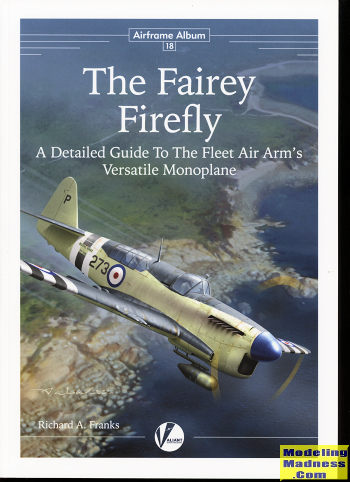 This latest
edition of Airframe Album concentrates on the Fairey Firefly naval fighter.
Development began once the Fulmar was well underway. The Fleet Air Arm always
wanted their fighters to be multi-purpose so those designed specifically for
naval use were two seaters with the rear seat for the observer/radio operator.
As a fighter, it had no rearward facing armament. The specifics for this
particular plane were unmet the first time designs were submitted so it took an
additional amount of time to get things going.
This latest
edition of Airframe Album concentrates on the Fairey Firefly naval fighter.
Development began once the Fulmar was well underway. The Fleet Air Arm always
wanted their fighters to be multi-purpose so those designed specifically for
naval use were two seaters with the rear seat for the observer/radio operator.
As a fighter, it had no rearward facing armament. The specifics for this
particular plane were unmet the first time designs were submitted so it took an
additional amount of time to get things going.
One thing that was required was the use of a Griffon
engine. This powerplant was showing a lot of promise and was a lot easier to
maintain than other options such as the Sabre. As usual, getting the airframe
right took a fair amount of work as the type had the usual teething issues. By
the time it was considered ready for prime time, it was fairly obvious that it
could not match the performance of land based fighters so was initially adapted
for other roles.
The role with the greatest need was night fighter,
however, British airborne intercept radars added a considerable amount of weight
and were not particularly good. The installation of a US system reduced the
weight, but still, it wasn't all that great. The biggest issue was that the pod
(which for the US system was mounted under the forward fuselage, had issues with
the metal props being used. To say it wasn't a very successful night fighter
would be about right. However, one place it did do quite well was as a ground
attack platform and it is in this role that the Firefly did well. Later
developments did better as both night fighter and ground attack and served with
distinction during the British involvement in the Korean war.
Post war the Firefly was used by a number of nations as
well as early planes being converted into two seat trainers. Both the Dutch and
Australians used them aboard carriers with the Swedes using a fairly large
number of them as target tugs. In fact, it is thanks to these tugs that there
are extant airframes as most were sourced from there once their service was
complete.
The book follows the usual script with a history of the
type, the different variants, close up images using technical manuals, museum
planes, and period
images. There is a section on the differences
between airframes and one on the various camouflage schemes worn by the
aircraft. This
series is not specifically a model building offering but there is a full build
article of the Trumpeter kit as two smaller half page builds of other kits. We also are provided with the
usual listing of kits, decals and accessories near the end.
In all, a most welcome addition to what is a superb
series of books and well worth the effort of picking up.
July 2022
Copyright ModelingMadness.com. All rights reserved. No
reproduction in part or in whole without express permission.
For more on Valiant Wings, including getting this book, visit
www.valiant-wings.co.uk. Thank you
for the review copy. You can get yours today
at this
link.
If you would like your product reviewed fairly and quickly, please
contact
me or see other details in the
Note to
Contributors.
 This latest
edition of Airframe Album concentrates on the Fairey Firefly naval fighter.
Development began once the Fulmar was well underway. The Fleet Air Arm always
wanted their fighters to be multi-purpose so those designed specifically for
naval use were two seaters with the rear seat for the observer/radio operator.
As a fighter, it had no rearward facing armament. The specifics for this
particular plane were unmet the first time designs were submitted so it took an
additional amount of time to get things going.
This latest
edition of Airframe Album concentrates on the Fairey Firefly naval fighter.
Development began once the Fulmar was well underway. The Fleet Air Arm always
wanted their fighters to be multi-purpose so those designed specifically for
naval use were two seaters with the rear seat for the observer/radio operator.
As a fighter, it had no rearward facing armament. The specifics for this
particular plane were unmet the first time designs were submitted so it took an
additional amount of time to get things going.